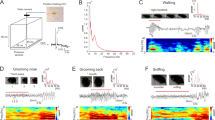Abstract
Spontaneous and drug-induced (haloperidol, apomorphine, and amphetamine) motor activity of rats was measured simultaneously via two distinct and independent methods: the classical optical scanning technique and a new procedure based on the piezo-electric principle. The latter procedure measured animal-induced mechanical vibrations of a flexible cage floor which were transduced into electric signals via piezo-electricity. The piezo method appeared to be relatively more sensitive in recording the small, stereotyped motor movements induced by apomorpine (0.63–≧10 mg/kg) and high doses of amphetamine (2.5–≧20 mg/kg). The optical scanning technique, on the other hand, was more sensitive in recording horizontal displacements across the cage such as induced by low doses of amphetamine (0.31–2.5 mg/kg). Both methods showed comparable sensitivity in recording the depression of behaviour induced by haloperidol (0.04–≧1.25 mg/kg) or low doses of apomorphine (0.04–0.16 mg/kg). The piezo method may complement the optical scanning procedure, and thereby enhance the information on the extent that test compounds modify animal behaviour.
Similar content being viewed by others
References
Brann MR, Finnerty M, Lenox RH, Ehrlich YH (1982) A device for the automated monitoring of stereotyped behavior. Prog Neuropsychopharmacol Biol Psychiatry 6:351–354
Colpaert FC, Van Bever WFM, Leysen JEMF (1976) Apomorphine: chemistry, pharmacology, biochemistry. Int Rev Neurobiol 19:225–268
Costall B, Naylor RY, Olley JE (1972) The substantia nigra and stereotyped behaviour. Eur J Pharmacol 18:95–106
Ellinwood EH Jr, Kilbey MM (1975) The influence of environmental factors and prepotent behavioural patterns on its topography and development. Biol Psychiatry 10:3–16
Ellinwood EH Jr, Molter DW, Staudermann KA (1981) An assessment of spectral analysis of amphetamine-induced behavior. Pharmacol Biochem Behav 15:627–631
Fray PJ, Sahakian BJ, Robbins TW, Koob GF, Iversen SD (1980) An observational method for quantifying the behavioural effects of dopamine agonists: contrasting effects of d-amphetamine and apomorphine. Psychopharmacology 69:253–259
Horowski R (1978) A new method for automatic registration of stereotyped behaviour in the rat. Arzneimittelforsch 28:2281–2286
Iwamoto ET (1984) An assessment of the spontaneous activity of rats administered morphine, phencyclidine, or nicotine using automated and observational methods. Psychopharmacology 84:374–382
Lal S, Sourkes TL (1972) Potentiation and inhibition of the amphetamine stereotypy in rats by neuroleptics and other agents. Arch Int Pharmacodyn Ther 199:289–301
Lal S, Sourkes TL (1973) Ontogeny of stereotyped behaviour induced by apomorphine and amphetamine in the rat. Arch Int Pharmacodyn Ther 202:171–282
Ljundberg T, Ungerstedt U (1977a) Different behavioural patterns induced by apomorphine: evidence that the method of administration determines the behavioural response to the drug. Eur J Pharmacol 46:41–50
Ljundberg T, Ungerstedt U (1977b) Apomorphine-induced locomotion and gnawing: Evidence that the experimental design greatly influences gnawing while locomotion remains unchanged. Eur J Pharmacol 46:147–151
Marcus MA (1982) Ferroelectric polymers and their applications. Ferroelectrics 40:29–41
Marsden CA, King B (1979) The use of doppler shift rader to monitor physiological and drug-induced activity patterns in the rat. Pharmacol Biochem Behav 10:631–635
Montanaro N, Vaccheri A, Dall'Ohio R, Gandolfi O (1983) Time course of rat motility response to apomorphine: a simple model for studying preferential blockade of brain dopamine receptors mediating sedation. Psychopharmacology 81:214–219
Niemegeers CJE, Janssen PAJ (1978) In vivo interaction of haloperidol and apomorphine. Arch Int Pharmacodyn Ther 236:43–50
Olpe HR (1978) Pharmacological manipulations of the automatically recorded biting behavior evoked in rats by apomorphine. Eur J Pharmacol 51:441–448
Randrup A, Munkvad I (1967) Stereotyped activities produced by amphetamine in several animal species and man. Psychopharmacology 11:300–310
Randrup A, Munkvad I (1968) Behavioural stereotypies induced by pharmacological agents. Pharmakopsychiatr Neuropsychopharmakol 1:19–26
Siegel S (1956) Nonparametric statistics for the behavioural sciences. McGraw-Hill, Tokyo
Stähle L, Ungerstedt U (1986) Different behavioural patterns induced by the dopamine agonist apomorphine analysed by multivariate statistics. Pharmacol Biochem Behav 24:291–298
Taylor KM, Snyder SH (1970) Amphetamine: differentiation by d and l isomers of behavior involving brain norepinephrine or dopamine. Science 168:1487–1489
Vanuytven M, Vermeire J, Niemegeers CJE (1979) A new motility meter based on the Doppler principle. Psychopharmacology 64:333–336
Author information
Authors and Affiliations
Rights and permissions
About this article
Cite this article
Megens, A.A.H.P., Voeten, J., Rombouts, J. et al. Behavioural activity of rats measured by a new method based on the piezo-electric principle. Psychopharmacology 93, 382–388 (1987). https://doi.org/10.1007/BF00187261
Received:
Revised:
Issue Date:
DOI: https://doi.org/10.1007/BF00187261




